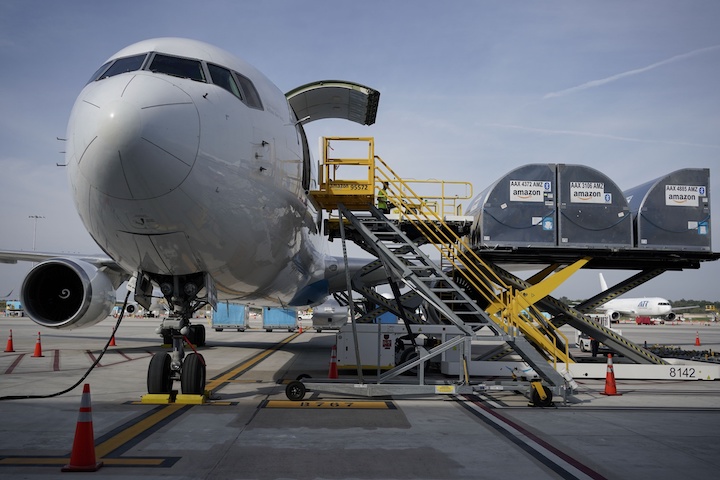Amazon touts drivers, warehouses as salve to supply-chain woes
Amazon.com Inc. is talking up the size of its delivery operation to ease public alarm that a supply-chain crisis could strangle holiday shopping.
In a corporate blog post Monday, the world’s largest online retailer said it has expanded its roster of drivers, warehouses and planes to handle an expected crush of orders in the coming weeks, potentially giving Amazon a competitive advantage. The blog also provided new visibility into the company’s effort to get goods to shoppers itself, rather than rely on the U.S. Postal Service or United Parcel Service Inc.
John Felton, the senior vice president of worldwide delivery services, wrote that the company can draw on several hundred thousand delivery drivers worldwide. Some 260,000 are employed by the company’s startup-in-a-box Delivery Service Partners, supported by “hundreds of thousands” more Amazon Flex drivers, who make deliveries from their own vehicles.
The company says it now has more than 800 delivery stations—facilities typically located closer to shoppers than Amazon’s massive exurban fulfillment centers. Bloomberg reported last year that Amazon planned to build about 1,500 of these delivery hubs.

Amazon says it has started bringing inventory into its warehouses from additional ports, doubled its ability to process shipping containers and expanded its network of ocean freight carriers. Felton wrote that Amazon’s rapidly growing air cargo arm will have more than 85 aircraft “later this season.” Amazon also operates a pool of more than 50,000 trailers, driven by contractors, the company said Monday.
“Our teams have been hard at work for months, focusing on capacity and demand planning to balance our customers’ needs against any supply chain or transportation challenges that may occur,” Felton wrote.
Amazon was down less than 1% at 10:50 a.m. in New York.
Amazon, which aims to hire some 150,000 seasonal workers, runs the risk of not having enough employees to meet demand in a tightening labor market, said Marc Wulfraat, president of MWPVL International Inc., a logistics consultancy.
But the company’s physical infrastructure represents a huge advantage over smaller rivals, he said on a conference call last week hosted by analysts with Jefferies LLC. Amazon can store inventory in warehouses that serve as import way stations, an advantage shared by the likes of Walmart Inc., Target Corp., Home Depot Inc. and Best Buy Co.
“The biggest, most powerful retailers will emerge from this relatively clean,” Wulfraat said. “It’s everybody else out there that depends on the holiday season that’s going to get hurt.”
Similar Stories

Inauguration of the Fly’in technology center: Daher paves the way for the future of decarbonized aviation
View ArticleHorizon Aircraft signs Letter of Intent with Discovery Air Chile Ltda., expanding global presence of Cavorite X7 Hybrid eVTOLs
New Horizon Aircraft Ltd. (NASDAQ: HOVR), doing business as Horizon Aircraft (“Horizon Aircraft” or the “Company”), a leading hybrid electric Vertical Take-Off and Landing (“eVTOL”) aircraft developer, announced today it…
View ArticleFlexiVan appoints new Chief Commercial Officer and new Chief Operating Officer
Flexi-Van Leasing, LLC (FlexiVan) announces the appointment of Chadwick (Chad) Heller, as its new Chief Commercial Officer, and Keith Saunders, as its new Chief Operating Officer.
View Article
WorldACD Weekly Air Cargo Trends (week 1) - 2025
View ArticleINVESTING IN AMERICA: Biden-Harris Administration announces $635 Million to continue expanding zero-emission EV charging and refueling infrastructure
New investments from the Bipartisan Infrastructure Law will add more than 11,500 electric vehicle charging ports and expand hydrogen and natural gas fueling infrastructure in communities nationwide
View Article
Averitt opens new Dothan, AL service center
View ArticleGet the most up-to-date trending news!
SubscribeIndustry updates and weekly newsletter direct to your inbox!





